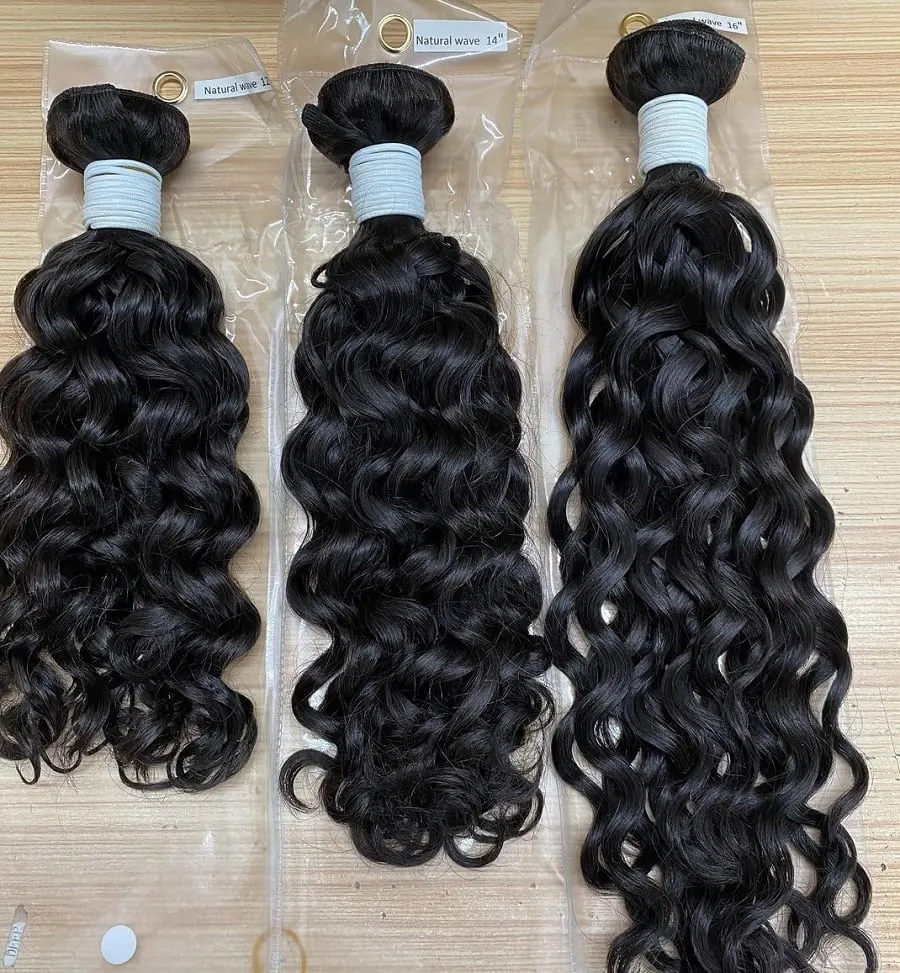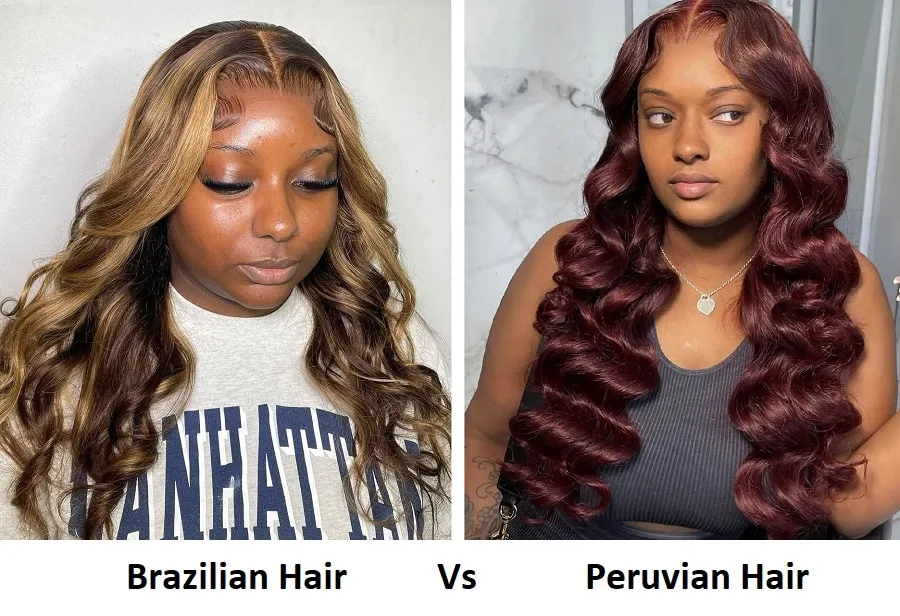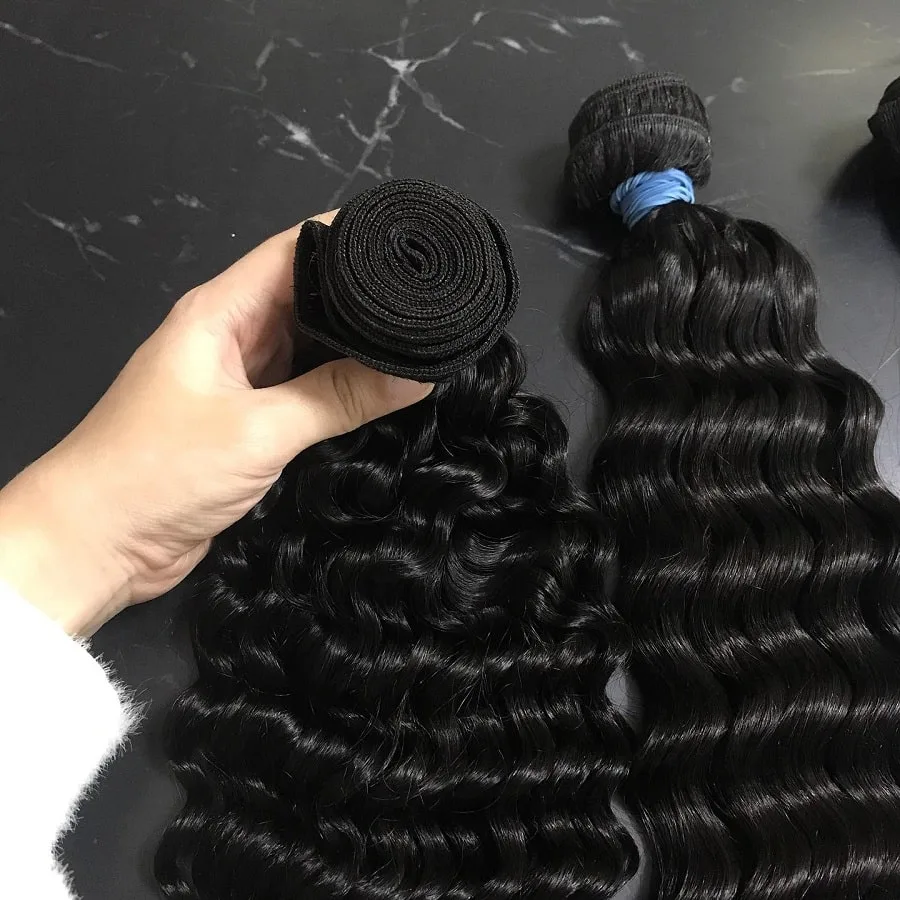Brazilian and Peruvian hair has a reputation for being beautiful. But there’s more to hair than just being attractive (which these two types undoubtedly are!), especially when choosing hair extensions or wigs.
So, with that in mind, this article will highlight the differences between Brazilian hair and Peruvian hair. We’ll also take a look at some of the similarities, so you can see exactly what makes these two variants so fabulously appealing.
Brazilian Hair Vs. Peruvian Hair At A Glance
Below is a Brazilian hair vs Peruvian hair comparison table showing the differences.
| Characteristic | Brazilian | Peruvian |
|---|---|---|
| Texture | Soft | Coarse |
| Thickness | Medium thickness | Thick |
| Cost | Cheaper | Relatively pricey |
| Availability | Easy to Find | Rare |
| Heat | Resistant to sun and heat damage | Sensitive to heat and sun damage |
| Volume | Bouncy, voluminous, lightweight | Bouncy, thick |
What Is Brazilian Hair?

Brazilian hair is a soft, lightweight, and medium-thick hair type that is often a deep natural black (1B).
Although Brazilian hair is said to originate from Brazil, the term “Brazilian hair” is frequently used as a descriptive term to define hair that is soft, lightweight, thick, and has natural waves.
In fact, this type of hair could come from anywhere in South America or Asia.
You can purchase Brazilian hair in one of three textures: wavy, straight, and curly. Virgin Brazilian hair is typically black but takes on color easily, making it an excellent customizable hair option. Despite its thickness, straight Brazilian hair rarely tangles.
What Is Peruvian Hair?

Peruvian hair, sometimes referred to as multipurpose hair, is sourced from small villages in Peru. The donors are typically of Spanish and Indian descent, resulting in a unique blend of textures in the hair.
This type of hair features thicker and fluffier strands, providing more volume while maintaining its lightweight quality. Furthermore, Peruvian hair is easy to manage and offers various styling options, including straight, wavy, and curly styles.
Peruvian hair typically comes in light brown, dark brown, and black shades. It is popular among Caucasian women, but also blends well with African American hair types and relaxed hair.
Key Differences Between Brazilian and Peruvian Hair

Peruvian and Brazilian hair differ in texture, thickness, price, availability, heat resistance, volume, usage, and longevity.
Let’s examine the differences between Brazilian and Peruvian hair in detail.
Texture
Peruvian hair is coarser and has more thickness, fullness, and deeper curls than Brazilian hair. In contrast, Brazilian hair is smoother to the touch.
Further, Peruvian hair has a less shiny appearance than its Brazilian counterpart, which has a luxurious sheen that gradually reduces within two to three washes. That leaves behind a natural radiance to the hair.
Quality
Both Brazilian and Peruvian varieties are made from 100% natural human hair. They aren’t processed beforehand or chemically treated, meaning both hair types are good quality.
Peruvian hair is better in terms of quality. Indeed, it lasts about three years, unlike Brazilian hair, which lasts eight to 12 months with proper maintenance. The longevity of Peruvian hair could be due to its heat-resistance capabilities.
Hair Type
Brazilian hair is versatile and works on various hair types. It is popular among African-American, African, Caribbean, and Mediterranean women. The hair comes in three styles: straight, wavy, and curly. Natural straight Brazilian hair is popular among Caucasian women looking to add volume.
Peruvian hair naturally grows straight, wavy, or curly, with a coarse texture making the type stand out. That texture ensures it assimilates with Caucasian and African hair.
Usage
Peruvian hair is popular among black women due to its ability to blend with natural hair texture. Due to that, people looking for realistic wigs or extensions may want to consider it.
Peruvian hair is easier to manage than Brazilian hair, making it an excellent choice for busy women.
Brazilian hair is common among women of West African descent. Its popularity can be attributed to its curly, wavy, and straight hair textures. Moreover, the type works well with curls and has a smooth, silky texture. While it is less manageable than Peruvian hair, it does not frizz much in humid climates.
Due to its thickness, you can use less Brazilian hair on your head. However, Peruvian hair makes up for its lack of thickness with its fluffiness and volume.
Cost
Human hair is expensive compared to its synthetic counterpart. If you find human hair at an unrealistically low price, chances are that it is synthetic or blended with synthetic hair.
That said, one key difference between Brazilian and Peruvian hair is cost. The Brazilian type is relatively cheaper compared to its Peruvian counterpart. That higher cost is due to rarity, as it isn’t easy to find.
Brazilian hair, in contrast, is readily available. You can find it from various vendors at relatively low prices.
Are There Any Similarities Between Brazilian and Peruvian Hair?

Brazilian and Peruvian hair have subtle similarities. They are made from 100% virgin human hair, meaning they have the same characteristics as natural hair, including texture, shine, and color. As with natural hair, you can use them for natural-looking hairstyles, heat treatment, bleaching, or coloring.
It’s common to find different colored hair strands within a bundle of either Brazilian or Peruvian unprocessed human hair. That is one of the common signs that the hair hasn’t been processed and is 100% human.
While both hair types have different textures, it’s not unusual to find inconsistencies in texture within one hair bundle, similar to what you would expect with your natural hair.
Peruvian and Brazilian hair come in wavy, curly, straight textures that match those found on virgin hair. Both blend well with African American hair.
Telling the difference between Brazilian and Peruvian hair can be difficult, especially if you have never encountered them.
Peruvian hair is coarser, thicker, rarer, pricier, and more heat-sensitive than Brazilian hair. With this information on hand, you can make a more informed decision and get the hair you deserve!
FAQs
You can mix Brazilian and Peruvian Hair. Mixing Brazilian and Peruvian hair is perfect for introducing body and bounce to your hair extensions or wigs.
Peruvian hair costs more than Brazilian hair due to it being rare and harder to find. That said, Peruvian hair will last longer and might be more economical in the long run.
